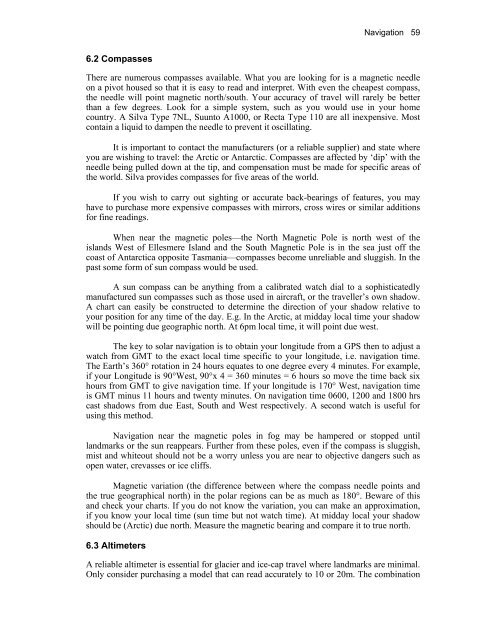Edited by Rachel Duncan 4th Edition ISBN 0-907649-91-2 London ...
Edited by Rachel Duncan 4th Edition ISBN 0-907649-91-2 London ...
Edited by Rachel Duncan 4th Edition ISBN 0-907649-91-2 London ...
Create successful ePaper yourself
Turn your PDF publications into a flip-book with our unique Google optimized e-Paper software.
6.2 Compasses<br />
Navigation 59<br />
There are numerous compasses available. What you are looking for is a magnetic needle<br />
on a pivot housed so that it is easy to read and interpret. With even the cheapest compass,<br />
the needle will point magnetic north/south. Your accuracy of travel will rarely be better<br />
than a few degrees. Look for a simple system, such as you would use in your home<br />
country. A Silva Type 7NL, Suunto A1000, or Recta Type 110 are all inexpensive. Most<br />
contain a liquid to dampen the needle to prevent it oscillating.<br />
It is important to contact the manufacturers (or a reliable supplier) and state where<br />
you are wishing to travel: the Arctic or Antarctic. Compasses are affected <strong>by</strong> ‘dip’ with the<br />
needle being pulled down at the tip, and compensation must be made for specific areas of<br />
the world. Silva provides compasses for five areas of the world.<br />
If you wish to carry out sighting or accurate back-bearings of features, you may<br />
have to purchase more expensive compasses with mirrors, cross wires or similar additions<br />
for fine readings.<br />
When near the magnetic poles—the North Magnetic Pole is north west of the<br />
islands West of Ellesmere Island and the South Magnetic Pole is in the sea just off the<br />
coast of Antarctica opposite Tasmania—compasses become unreliable and sluggish. In the<br />
past some form of sun compass would be used.<br />
A sun compass can be anything from a calibrated watch dial to a sophisticatedly<br />
manufactured sun compasses such as those used in aircraft, or the traveller’s own shadow.<br />
A chart can easily be constructed to determine the direction of your shadow relative to<br />
your position for any time of the day. E.g. In the Arctic, at midday local time your shadow<br />
will be pointing due geographic north. At 6pm local time, it will point due west.<br />
The key to solar navigation is to obtain your longitude from a GPS then to adjust a<br />
watch from GMT to the exact local time specific to your longitude, i.e. navigation time.<br />
The Earth’s 360° rotation in 24 hours equates to one degree every 4 minutes. For example,<br />
if your Longitude is 90°West, 90°x 4 = 360 minutes = 6 hours so move the time back six<br />
hours from GMT to give navigation time. If your longitude is 170° West, navigation time<br />
is GMT minus 11 hours and twenty minutes. On navigation time 0600, 1200 and 1800 hrs<br />
cast shadows from due East, South and West respectively. A second watch is useful for<br />
using this method.<br />
Navigation near the magnetic poles in fog may be hampered or stopped until<br />
landmarks or the sun reappears. Further from these poles, even if the compass is sluggish,<br />
mist and whiteout should not be a worry unless you are near to objective dangers such as<br />
open water, crevasses or ice cliffs.<br />
Magnetic variation (the difference between where the compass needle points and<br />
the true geographical north) in the polar regions can be as much as 180°. Beware of this<br />
and check your charts. If you do not know the variation, you can make an approximation,<br />
if you know your local time (sun time but not watch time). At midday local your shadow<br />
should be (Arctic) due north. Measure the magnetic bearing and compare it to true north.<br />
6.3 Altimeters<br />
A reliable altimeter is essential for glacier and ice-cap travel where landmarks are minimal.<br />
Only consider purchasing a model that can read accurately to 10 or 20m. The combination

















